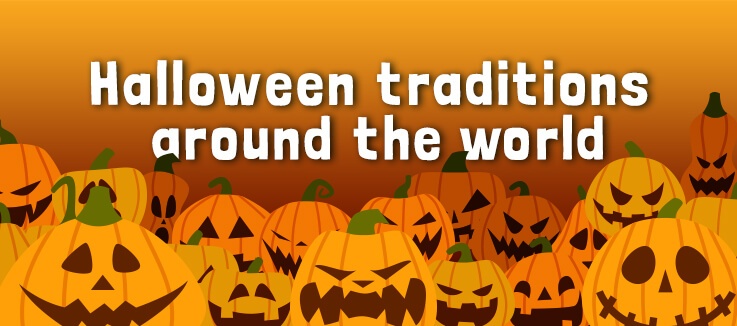7 Halloween traditions from around the world

Are you an adult that loves dressing up as a superhero? Well, Halloween is most likely your favourite time of the year. No longer do you need to hide your love for bright red underpants and floor-length capes from the world. With Halloween, you can don your superhero tights or dress up as your favourite character from a movie, a book, pop culture or even real life.
Here at Fair Go, we like to celebrate by dressing Kev the Koala up as a pumpkin. We also kick start the spooky season by giving away a host of bonuses and running some exciting new promotions. In other parts of the world though, Halloween is celebrated a lot differently.
In this article, we shine a light on 7 Halloween traditions from around the world. From festivities inspired by the genesis of Halloween itself to rituals of worship with roots in voodoo magic, these Halloween customs are about more than just trick or treating and carving pumpkins. But before we launch into these Halloween traditions from around the world, here’s a bit of background on this downright creepy day.
When is it celebrated?
Halloween falls on October 31st every year. In some places it’s a national holiday while other nations simply celebrate by taking part in local events and traditions.
How did it begin?
Halloween originated with the festival of Samhain, held by the Celts hundreds of years ago. The actual word “Halloween”, however, only dates back to 1745, when Samhain was anglicised by Pope Gregory III, shortly after he designated November 1st as All Saints Day.
The term “Halloween” also went through various changes before coming about. This is due to the fact that in Scotland, the word "eve" is “even”, which is shortened to “e'en” or “een”, so that over time, “All Hallows Even” eventually morphed into “Halloween”.
What does it symbolise?
As we mentioned, Halloween was originally a Celtic festival. During this festival people would light bonfires and wear costumes in an effort to ward off evil spirits. The 31st of October also marked the end of the harvest and of summer and the start of the colder months. In Celtic folklore, it was believed that during this time the boundary between the living and the dead blended.
These days Halloween has veered away from being a religious holiday and evolved into more of a commercial enterprise in many western countries. Activities such as parties, trick or treating, the eating of lollies and the hollowing out and carving of jack-o-lanterns have therefore replaced many customary Halloween rituals.
1. Samhuinn, Ireland and Scotland
Samhuinn or Samhain is where it all began. An ancient Celtic and Pagan ritual that started the Halloween tradition. Although the times have changed and most of the world no longer dances semi-naked around a fire to frighten off ghosts, it seems nobody told the people of Ireland and Scotland that.
In fact, they still party like their ancestors did hundreds of years ago. With bonfires, games and iconic dishes such as barmbrack and Irish fruitcake shared between revellers. In Edinburgh, the locals throw a spectacular fire festival and invite storytellers to spin a yarn about the battle between the Summer and Winter King.
2. El Dia de los Muertos, Mexico
El Dia de los Muertos, otherwise known as “the Day of the Dead”, is celebrated from the 1st of November until the 2nd in Latin American countries such as Mexico. While it’s not called Halloween, this is without doubt the closest thing you’ll get to celebrating All Hallows Eve in this part of the world.
During El Dia de los Muertos it’s believed that the gates of Heaven open up at the stroke of midnight on the 31st of October. The souls of dead children then return to Earth to be reunited with their families for 24 hours. When the 2nd of November finally arrives, the souls of the adults also come down to join the party. Alters full of foods and drinks such as peanuts, soda, stacks of tortillas and a special bread called pan de muerto, “bread of the dead”, are all left as an offering for the returning spirits.
3. Pangangaluluwa, Philippines
In Filipino folklore, Pangangaluluwa is pretty much the local version of Halloween, whereby kids go door to door dressed up in costumes and ask for prayers for those lost souls stranded in purgatory. By doing so they’re meant to assist these souls in moving on to their final destination. The singing of songs on a house’s doorstep is also a common practice during Pangangaluluwa.
While this still goes on in some provinces, many of the older traditions have been replaced by modern activities such as trick or treat. One thing hasn’t changed though, which is the practice by which Filipinos flock to the cemetery and spend time with their dearly departed, cleaning up the family tomb and cutting the grass around the site.
4. Ognissanti, Italy
Celebrated on the 1st of November, La Festa di Ognissanti or simply Ognissanti is a national holiday in Italy, Banks shut down, post offices close their doors and schools throughout the nation take a day off. Everyone can then honour the many saints and martyrs who died for the catholic church and tuck into a massive feast of food… presumably cooked by a talented Italian Nonna who knows her way around a pot of pasta.
A midday mass and a colourful procession down a city or town’s main street is also observed in certain parts of the country. While traditionally a solemn occasion, there’s also a festive component to Ognissanti. Between leaving fresh flours on graves and putting a red candle in your window at sunset, you’ll also get to enjoy a few drinks and good company with friends and family.
5. Ñatitas, Bolivia
In Bolivia, Halloween takes on a rather macabre twist. With thousands of Peruvian Indians celebrating Fiesta de las Ñatitas, also known as the festival of the little pug-nosed ones. Taking place on the 8th of November, this celebration is a special time of the year when Peruvian’s bring out the skulls of their relatives, which are kept in the home to watch over the living, and decorate them with flowers as a sign of respect.
Gifts are also exchanged and like El Dia de los Muertos, many Peruvian’s head to their local cemetery to spend time with the deceased. While traditionally an indigenous custom, these days Fiesta de las Ñatitas blends both Catholic and native beliefs, with the biggest celebration taking pace in La Paz’s General Cemetery.
6. Ghede, Haiti
On the 2nd of November, Haitians pay tribute to their deceased ones by providing them with offerings of their favourite foods and vices, such as rum, while also honouring the god of the dead, Gede. With these offerings they aim to entice the dearly departed back home for a visit and ask for luck and good things from the spirits. Some people will also decorate their faces to mimic the dead, with black and white paint applied to the skin around the eyes. Others will clean the tombs of their loved ones.
As the night falls and the revelries hit fever pitch, Voodoo practitioners will begin drumming, singing and praying at a cross that’s rising from a tomb to summon the spirits. This partying is meant to help both young and old get busy living while giving thanks to family and friends who have since passed away.
7. Pchum Ben, Cambodia
From the end of September to the middle of October, Buddhists come together in Cambodia to observe an ancient religious holiday called Pchum Ben. Considered to be somewhat similar to our Halloween, it’s an opportunity for Cambodians to commemorate their ancestors and even celebrate the elderly.
People present foods such as beans wrapped in banana leaves to friends and family while flowers are offered to the dearly departed. These traditions stem for the belief that during Pchum Ben, the gates of hell open and spirits caught in purgatory roam the land of the living searching for food. The catch here is that if food cannot be found by the hungry ghosts, they’ll be forced to put a curse on their descendants.
Celebrate Halloween with everyone’s favourite online casino in Australia by betting with Fair Go today!









